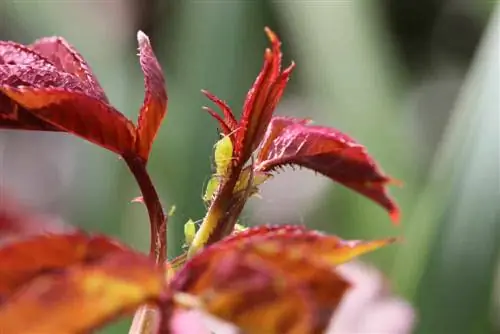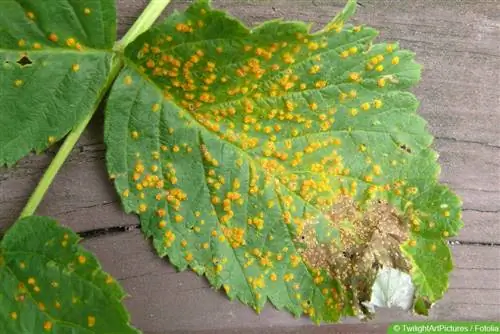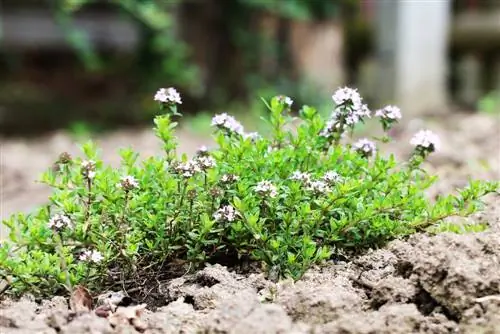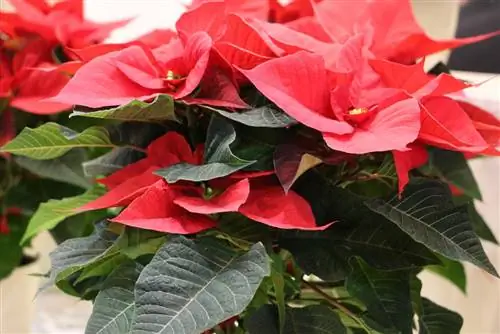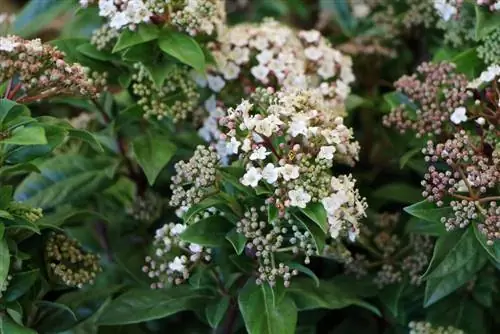- Author admin [email protected].
- Public 2023-12-17 03:39.
- Last modified 2025-01-24 12:45.
Since thyme quickly tends to become woody if little care is taken, regular pruning is extremely important and should not be ignored. An important point is the right timing and type of cut.
When is the best time?
The following pruning and care methods are used for thymes and are effective in preventing the shrub from becoming woody:
- pruning
- Rejuvenation cut
- Topiary
Tip:
Harvest the thyme by hand regularly. By harvesting the shoots as an herb for cooking, you encourage the plant to grow. At the same time it is a prevention against woodiness and fresh herbs in the house are always welcome.
When does the pruning take place?
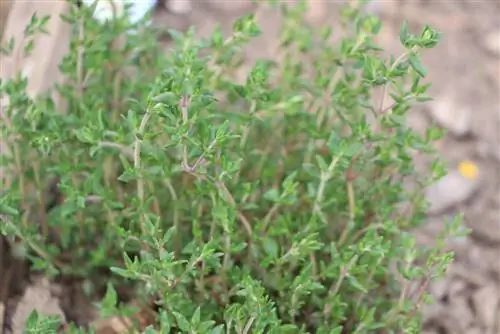
Pruning is essential for the he alth of the thyme and ensures that it does not become woody. Light pruning is done once in spring after the first frost and in summer after flowering. Caution: pruning in spring (March, April) may only be carried out as soon as you are sure that there is no longer any threat of frost. This is extremely important, otherwise the freshly cut thyme can freeze due to the cold in the garden.
Pruning: a guide
Annual pruning is used to keep your thyme fresh and he althy and not succumb to woodiness. To do this correctly, follow these steps:
- Before you start pruning, choose a good pair of pruning shears. This should be sharp to avoid damage to the plant and to make work easier. Classic secateurs are recommended here, as thymes don't have any really hard shoots.
- Before cutting, you must check the bush for areas that have previously become woody. All subshrubs have woody areas as this is part of the growth of the plant. Shoots that are woody are usually located close to the ground and are brownish in color compared to fresh shoots. Fresh thyme is green and bends easily, while the woody parts are harder and stronger.
- Now carefully cut back the entire bush and don't be afraid to cut off a lot of greenery. Make sure to leave about two to three centimeters of green shoots when cutting. These are particularly important so that the plant can form further shoots. Repeat this step on the entire shrub until it is trimmed.
- Important: Never cut into the woody shoots. Woodiness is part of the growth of the plant and the harder parts of the plant also take care of the formation of new shoots. If you cut into the woody areas, the herb may no longer grow. So stay away!
- Work with great care throughout the cut and cut off enough green shoots. This allows the shrub to develop strong and he althy new shoots.
- Remove any cut plant material, including flowers, and loosen the soil around the thymes slightly. After pruning, the supply of nutrients is particularly important. To do this, use either compost, lime or a suitable fertilizer if it has been a while since you last fertilized. But don't overdo it, otherwise the shrub can become overloaded with nutrients.
- If you live in an area where cold nights or frost are common, you should protect the shrub from the cold after cutting. Brushwood, bark mulch and coconut mats are ideal for winter and cold protection, as they provide the plant with enough warmth.
- Depending on the speed of growth, repeat the pruning at the end of summer, but not in late autumn. Repeat pruning regularly to maintain strong thyme bushes.
Attention:
Never cut off young shoots! Look for older shoots that have not yet become woody and shorten them. These are usually shoots from last year that overwintered and now need a fresh cut.
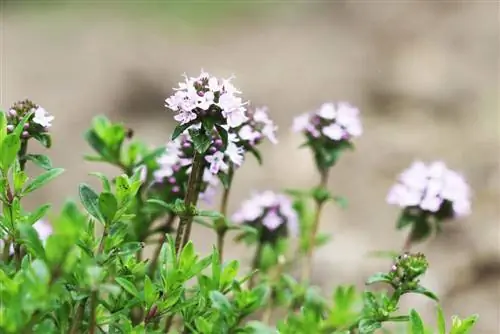
You should also note the following points so that the thyme can grow back in a relaxed manner:
- Never tear off shoots
- Thymes prefer a warm climate
- Drained soil is recommended
- Fertilize sparingly
- Pruning can be used for repotting
- Pruning helps detect plant diseases
- Don't do it too late in the year
When is the rejuvenation cut used?
The rejuvenation cut is not necessary if the thyme is cared for regularly. If the thyme is harvested as a culinary herb, this cut is not necessary as it does not become woody as a result of this use. However, if the shrub has had to go a long time without being pruned or harvested, rejuvenation pruning is essential in late autumn after the first frost. Since you cut a lot of plant material from the herb that is woody with this cut, the plant recovers over a period of a year and also needs to undergo a rejuvenation cut the following fall.
How does the rejuvenation cut work?
While pruning focuses on the annual care of the thyme, rejuvenation pruning is important for the plant if it has been neglected. The rejuvenation cut brings the plant back to life. This cut looks like this:
- Use the same utensils as for pruning and again be careful not to cut into the woody shoots.
- As with pruning, look for the oldest shoots you can find. The main focus here is to look for the shoots that are located directly on the most woody area and are themselves on the verge of woodiness. This can be a little more difficult if you have ground cover species that are close together. But this step is essential to enable the regrowth of fresh shoots.
- Only a third of the total amount of the oldest shoots is removed. This means that not the entire bush is pruned, otherwise the herb would not survive in the winter.
- Half of these shoots are now cut off to enable fresh plant parts to sprout.
- It is normal that the bush may appear very thin after this procedure. This is also necessary because shrubs that have not been cared for for a long time often suffer from overgrowth and find it increasingly difficult to supply themselves with nutrients.
- After you prune the shrub, prune it in the same way at the same time the following year. Since the rejuvenation cut takes place over a long period of time, the plant can recover in a relaxed manner and thus sprout vigorously.
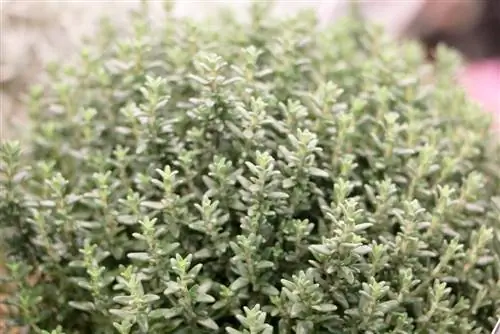
The rejuvenation cut helps to protect old plants from further woodiness. Because thyme can grow for several years, it can be found in many gardens, even if the owner doesn't know it. These shrubs suffer greatly from woodiness because they are rarely cut and can calcify over time. Calcification is not only bad for the plant. The soil also suffers from calcification caused by the thyme. Lime is mainly used in the garden to deacidify the soil. However, too much lime deprives the soil of nutrients. This problem is counteracted by the rejuvenation cut.
When is it time for the topiary?
You can use topiary to shape your thyme if you don't use it primarily as a culinary herb. Since thymes are very suitable as ground cover for meadows and the garden, topiary is necessary, as is the case with specimens that have a solitary position in the garden. Topiary pruning is carried out in spring after the first sprouts and should be carried out carefully so as not to remove too much of the fresh shoots.
Beautify the garden with topiary
If you use thyme as a ground cover or as a special accent in your green oasis, a topiary is particularly worthwhile. As the name suggests, it brings the thyme into your preferred shape and is therefore attractively integrated. When cutting topiary, you also have to pay attention to a few things that would otherwise hurt the plant.
- Before cutting, think about the shape you want the shrub to have. For example, this can be a sphere.
- Now cut off a maximum of a third of the shoots in length and keep an eye on the shape so as not to cut off too much. This is particularly important because it allows the herb to grow quickly and take on the desired design.
- Please note: Never cut off more than a third when cutting topiary. If you want to achieve a shape that exceeds this guideline, repeat the pruning next year and adjust the shape on an annual basis. This is the only way to protect the plant from damage.
Thyme has faded? What now?
If the thyme has withered after the summer and no more flowers grow, you can simply cut off the withered parts. This is also recommended during the flowering period, for example when a shoot dies. Since it can no longer be supplied with nutrients, the entire shoot should be removed, including the flower. You don't need to worry because the withered flowers would only put further strain on the plant.
Tip:
When cutting the flowers, be careful not to cut off too much or injure the rest of the bush. By removing the wilted flowers, you also ensure a he althier and tidier appearance of the herb. This is particularly recommended for ground cover types of thyme, as they otherwise appear untidy.


